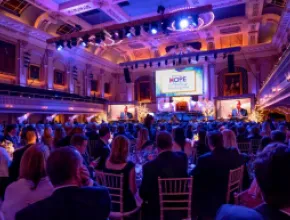Whether it’s the preserved former home of a literary giant, famous entrepreneur or other iconic figure, historic homes not only let visitors step into a piece of history, but into another life. These slices of history also serve as atmospheric backdrops for special events, often featuring homes of architectural note as well as inspiring outdoor spaces.
Stan Hywet Hall & Gardens
Akron, Ohio’s only National Historic Landmark, was home to F.A. Seiberling, who founded the Goodyear Tire & Rubber Company. Between 1912 and 1915, he and his wife, Gertrude, built their country estate and named it Stan Hywet, which translates to “stone quarry” in Old English.
The home was part of a short-lived American Country Estate building boom, which was already on the decline by the 1920s. Many of those mansions have been razed, but Stan Hywet was donated to a nonprofit organization. Today the Manor House is considered one of the best examples of Tudor Revival architecture in America, and is open to groups.
The Manor House auditorium can host up to 200 for a buffet, while the Carriage House can host up to 100. The gardens and grounds, which originally spanned more than 1,000 acres, feature 70 remaining acres.
Fallingwater
Another National Historic Landmark, Fallingwater in southwestern Pennsylvania, is one of Frank Lloyd Wright’s most arresting architectural achievements. Built for the Kaufmann family in the 1930s, the multitiered house sits like a piece of outdoor sculpture over a waterfall in the midst of a hardwood forest.
Located about 90 minutes from downtown Pittsburgh, Fallingwater is a popular spot for group tours. While events cannot be held in the house itself, the Barn at Fallingwater, originally built in 1870 and located about 500 yards north of Fallingwater at the entrance to the Bear Run Nature Reserve, is available for functions for up to 125 people.
The Barn features three primary spaces for meetings and catered events. The Fireplace Room, originally a milking parlor from the time when the barn was an active dairy farm, has since been renovated and now can serve as an event space. The Threshing Room, once used for hay storage, can be used from May through mid-October.
Large sliding doors open to the rear of the Barn, allowing events to expand to the outdoors. Tents can be added to this area to provide additional covered space.
Cranwell Resort, Spa & Golf Club
In 1853, the Rev. Henry Beecher, a noted abolitionist and advocate of women’s suffrage, purchased the hilltop site in the Berkshires of western Massachusetts where the Cranwell Resort now stands. Enchanted with the views, he proclaimed, “From here, I can see the very hills of heaven.”
In later decades, the property had a succession of owners that included furniture magnate John Sloane, who constructed the current Tudor-style mansion that forms the nucleus of Cranwell Resort. Sloane also commissioned Frederick Law Olmstead, the landscape architect who created New York’s Central Park, to design Cranwell’s extensive grounds.
Today the property is a 107-room hotel with amenities that include an 18-hole championship golf course and a spa. A popular site for meetings and executive retreats, Cranwell offers function spaces that range from a stately boardroom on up to a ballroom accommodating up to 200 guests. From such outdoor areas as the Rose Terrace, the views described by Beecher can still be enjoyed.
Chesterwood
Chesterwood is the studio and home of Daniel Chester French, the sculptor most famous for the sculpture of Abraham Lincoln in the Lincoln Memorial in Washington, D.C., and The Minute Man statue in Concord, Mass. Nestled in the Berkshires, the estate in Lenox, Mass., is also known for its mountain vistas and Italianate gardens in French’s own design.
Visitors can tour French’s studio, which features a single-guage railroad track for rolling the large sculptures outdoors for viewing in natural light, and the Barn Gallery, which contains what is possibly the largest single collection of work by any American sculptor. The home is furnished with American and European antiques as well as paintings collected by the sculptor.
Chesterwood, with its terraces, galleries and sweeping lawns, provides a variety of locations for indoor and outdoor events ranging from small dinners on up to receptions for up to 500 people.
Hillwood Estate, Museum & Gardens
Framed by 13 acres of gardens on the edge of Washington, D.C.’s, Rock Creek Park, Hillwood is the magnificent legacy of Marjorie Merriweather Post, daughter of cereal magnate C.W. Post. The brick Georgian-style mansion is a showcase for Post’s renowned collection of Russian and French decorative art, including Faberge eggs and jewels once worn by Catherine the Great.
Groups can enjoy tours of the mansions, which offers 36 rooms of treasures with docents stationed along the way. The lush grounds include a Japanese garden with a waterfall, a circular rose garden and acres of native woodland plantings.
Three areas on the grounds are available for receptions, including the Adirondack Building, which accommodates up to 80 people, and the Visitors Center, which accommodates up to 150.
Capt. Frederick Pabst Mansion
Completed in 1892, the Flemish Renaissance-style mansion of Capt. Frederick Pabst has long been considered the jewel of a famous avenue of mansions in Milwaukee, Wis., called Grand Avenue.
For 67 years, five Catholic archbishops and numerous priests and nuns called the former Pabst residence home. In 1975, the mansion was sold. While the Archdiocese held hope that a preservation group would purchase and maintain the structure, it was sold to a party who wanted to tear down the mansion and build a parking structure. But before the deal was done, a local entrepreneur purchased the house and held onto it until a small preservation group, Wisconsin Heritages, could attain the funds needed to preserve it.
By 1978, after receiving a large state grant and holding 23 mortgages in their hands, the heritage organization was able to purchase the mansion and open the house to the public. Since those early days much has been accomplished to restore the mansion to its original appearance. In the summer of 1998, the building was renamed Captain Frederick Pabst Mansion to reflect the renewed focus solely on the restoration of the Pabst Mansion.
Today the mansion stands as one of the city’s most renowned residences, and has been used for everything from private dinners to meetings. The mansion can host 125 for cocktail receptions and up to 70 for sit-down dinners in the master suite. The mansion is available for rent in the evenings, though business meetings can be accommodated during daytime hours.
Edsel and Eleanor Ford House
In Grosse Pointe, Mich., the Edsel and Eleanor Ford House spans 87 acres and displays the couple’s tastes in art and architecture. The only son of automobile pioneer Henry Ford, Edsel began his career at the Ford Motor Company in 1912, and by the age of 26 became its president. In 1916 he married childhood friend Eleanor Hudson, and by 1925 the couple had four children.
In searching for a home for the family, Ford chose a plot his father owned in an exclusive lakeside suburb north of Detroit. The couple requested the architects create a home inspired by the stone cottages they had seen in the Cotswold region of central England.
The result was an elaborate blend of Cotswold-style architecture translated to a 60-room mansion with access to the lakeside. The couple filled their house with English and French antiques, and several rooms featured artworks by masters such as Matisse, Cezanne and Diego Rivera.
The house has been open to the public for 30 years. Though the home is off-limits to events, groups can use the visitor center, which opened in 1990. The terrace area is also available for receptions and other functions.
Groups can tour the house during receptions, according to Donna Buchanan, group tour sales director, and there is plenty of flexibility on using the property.
“We do everything from breakfast to a dessert tour in the evening,” she says.
Thomas Edison House
The Thomas Edison House is located in the historic Butchertown section of Louisville, Ky., which, as its name implies, has been the center of the city’s meat industry for over 200 years. Thomas Edison, who came to Louisville in 1866 at the age of 19 to work as a telegraph key operator, lived in Butchertown during the years he worked in Louisville.
The cottage was built around 1850 as a very basic shot-gun duplex, and is now a museum showcasing some of Edison’s most famous inventions. Most of his early inventions were either improvements of the telegraph or similar machines, such as a fire alarm telegraph. The museum also hosts a full and varied light bulb collection in honor of Edison’s 1879 invention of the incandescent light bulb.
Groups can hold events in the Edison house, which accommodates up to 50 people for a standing reception. The garden, which provides a formal setting and can be tented, also accommodates up to 50 people.
For More Info
Captain Frederick Pabst Mansion 414.931.0808 www.pabstmansion.com
Chesterwood 413.298.3579 www.chesterwood.org
Cranwell Resort, Spa & Golf Club 413.637.1552 www.cranwell.com
Edsel and Eleanor Ford House 313.884.4222 www.fordhouse.org
Fallingwater 724.329.8501 www.fallingwater.org
Hillwood Estate, Museum & Gardens 202.243.3914 www.hillwoodmuseum.org
Stan Hywet Hall & Gardens 330.836.5533 www.stanhywet.org
Thomas Edison House 502.585.5247 www.historichomes.org






